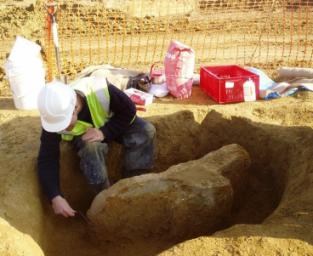


This magnificent find, a fairly complete skull with both horn-cores intact had just been discovered on the very last stretch of link road to be carved out of the landscape, and the workers with their bulldozers were waiting to finish off the final section of the roadway. The particularly large and intact yet fragile specimen clearly needed specialist attention. A very solid jacket was made to encapsulate the whole specimen once it was fully excavated - one robust enough to protect it, without flexing, when lifted by the bulldozer and to keep it safe on the journey back to Oxford.
This jacket was made of plaster of paris and coarse hessian scrim with wooden splints over protective layers of tissue paper and foil.
In 2010 this huge specimen was dejacketed, prepared and conserved
so that the specimen could be identified and written in to the archaeological report. The specimen is shown below
left before preparation (the hammer is just for scale!) and after preparation, below right. As the specimen had been
fractured during burial processes and the bone preservation was weak, the decision was made to leave the skull and horn cores partly
supported by the rigid plaster jacket. To do otherwise was to risk the specimen breaking in many places, and it had already
been prepared enough to allow a full identification and description.
A secure wooden and Plastazote foam base was made to transport and permanently store the specimen.


For more details about what we can do for you, or for a quote, please contact:
enquiries@natural-history-conservation.com
We are members of the United Kingdom Institute for Conservation of Historic and Artistic Works